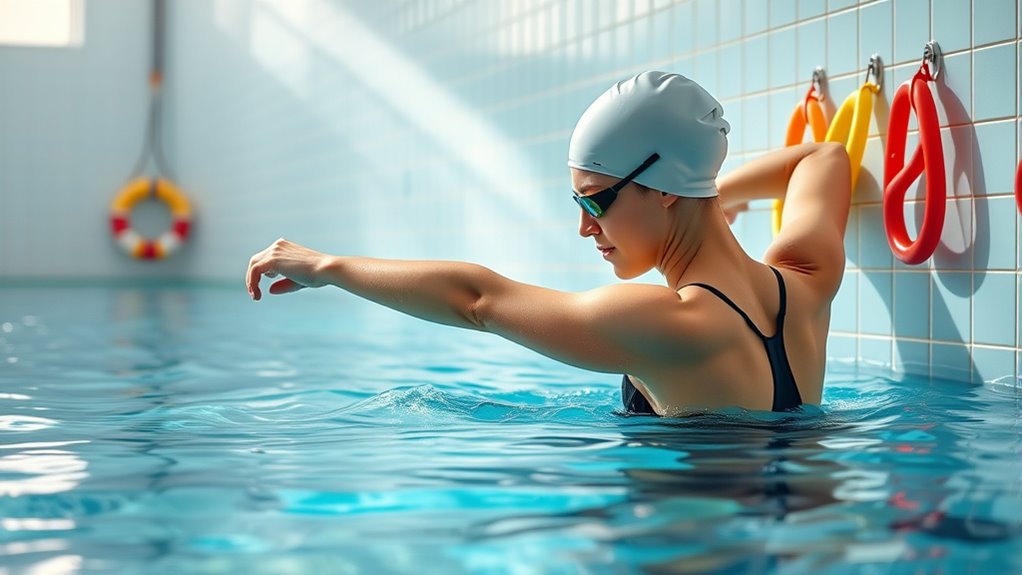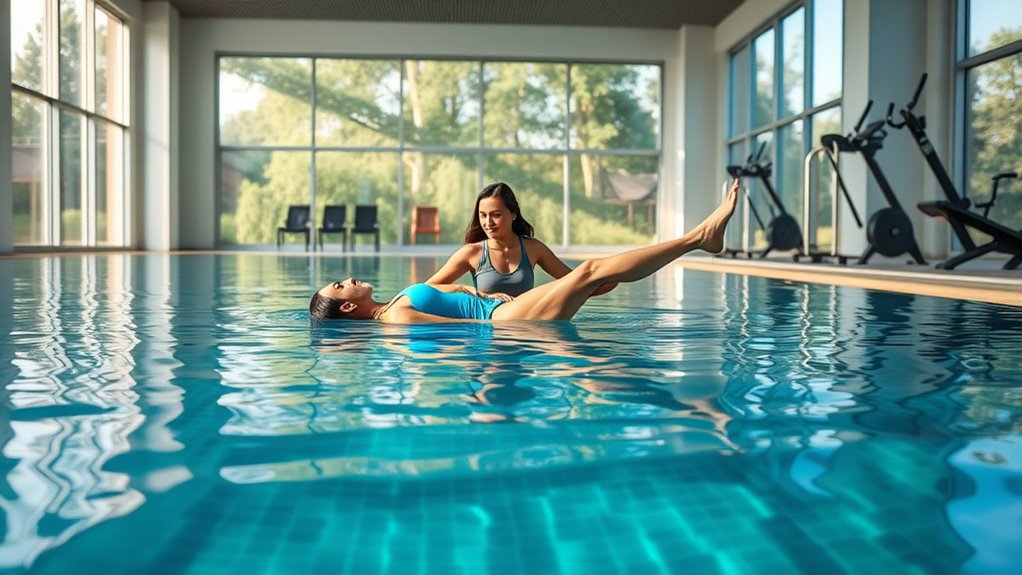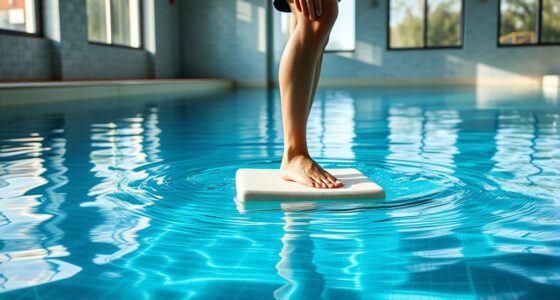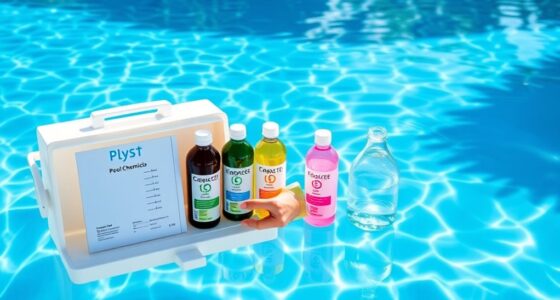Using your pool for injury rehabilitation is a smart way to promote healing while minimizing pain. You can start with gentle water exercises like stretching or walking in shallow water, gradually increasing resistance and movement intensity. The water’s support helps you move confidently and reduces joint stress. Consistent, controlled routines speed recovery and rebuild strength safely. Keep an eye on your body’s signals, and you’ll find plenty of tips to maximize your rehab journey.
Key Takeaways
- Start with gentle water exercises like stretching and range-of-motion movements to promote healing and prevent stiffness.
- Incorporate shallow water walking or jogging to strengthen muscles and improve stability safely.
- Gradually increase resistance and dynamic movements, listening to your body and avoiding pain.
- Use water’s support to perform functional movements that mimic daily activities for better recovery.
- Follow a consistent routine of short, frequent sessions, including warm-up and cool-down, for optimal injury rehabilitation.

If you’re recovering from an injury, your pool can be a valuable tool for rehabilitation. One of the main advantages of aquatic therapy is water resistance, which provides gentle yet effective resistance that can help you regain strength without putting too much strain on your joints or muscles. Unlike traditional workouts, water resistance allows you to perform low-impact exercises that still challenge your body, making it ideal for easing back into movement after an injury. The hydrotherapy benefits are substantial—water supports your body, reducing weight-bearing stress, which minimizes pain and promotes quicker healing. This support allows you to move more freely and confidently, encouraging you to engage in movements that might be painful or difficult on land.
Aquatic therapy offers gentle resistance and support for safe, effective injury recovery.
To start, you should focus on gentle, controlled movements that target your injury area. Begin with simple stretching and range-of-motion exercises, such as slowly moving your limbs through the water, feeling how the resistance gently works against your muscles. As you progress, incorporate walking or jogging in the shallow end, using the water’s resistance to strengthen your legs and improve stability. Remember, the key is to listen to your body. If an exercise causes pain beyond mild discomfort, stop immediately and consult your healthcare provider. The goal is to challenge your muscles just enough to promote healing without risking further injury.
Using the pool for injury rehab also allows you to incorporate functional movements that mimic everyday activities. For example, water-based squats or leg lifts can help rebuild muscle endurance and coordination. Because water cushions your joints, you can perform these exercises more confidently, which is essential during early recovery stages. Over time, as your strength and mobility improve, you can gradually increase the intensity by adding more resistance or trying more dynamic movements, always under supervision or following your healthcare provider’s advice.
It’s vital to set a consistent routine. Short, frequent sessions are more effective than infrequent, lengthy workouts. Typically, 15 to 30 minutes several times a week can produce noticeable benefits. Remember to warm up before exercising and cool down afterward, both within the water, to prevent stiffness. Proper hydration and listening to your body’s signals are equally important. If you experience pain, dizziness, or fatigue, take a break and seek guidance. The hydrotherapy benefits of water resistance combined with a carefully planned rehab routine can accelerate your recovery, helping you regain strength, flexibility, and confidence in your movement.
Frequently Asked Questions
Can Pool Rehab Replace Physical Therapy Sessions Entirely?
You might wonder if pool rehab can fully replace physical therapy. While water’s buoyancy and temperature help reduce pain and improve mobility, they can’t address all underlying issues or provide personalized guidance. Pool safety is essential, especially with water temperature control to prevent overheating or chills. It’s best to use pool rehab as a supplement, not a complete substitute, ensuring you follow your healthcare provider’s advice for maximum recovery.
What Types of Injuries Are Most Suitable for Pool Rehabilitation?
You might find pool rehabilitation best suited for injuries like joint instability or muscle weakness. The water’s buoyancy supports joint stability and reduces pain, making movement easier. It’s ideal for muscle strengthening without excessive strain. If you’re recovering from ligament injuries or post-surgical rehab, the pool allows controlled, low-impact exercises that promote healing and stability. Always consult a professional to guarantee your specific injury benefits from aquatic therapy.
How Often Should I Perform Pool Exercises for Recovery?
You should perform pool exercises based on your injury severity and recommended exercise frequency from your healthcare provider. Generally, starting with 3 to 5 sessions per week allows your body to adapt and recover without overdoing it. As your strength improves and pain decreases, you can gradually increase or adjust the frequency. Always listen to your body and consult your therapist for personalized guidance.
Are There Specific Pool Temperatures Recommended for Injury Rehab?
Imagine warm water enveloping your body, soothing muscles and easing pain. For injury rehab, water temperature guidelines typically recommend 88-92°F, optimizing hydrotherapy benefits by promoting circulation and comfort. Too hot, and you risk overheating; too cold, and it might hinder healing. Maintaining this temperature range creates a gentle, therapeutic environment that accelerates recovery, ensuring your body receives the ideal conditions for healing and pain relief.
Is Swimming Necessary, or Can Water Exercises Suffice?
You don’t necessarily need to swim; water exercises can be equally effective. Water resistance provides gentle, yet effective, muscle engagement, while buoyancy effects reduce joint stress. You can focus on walking, stretching, or resistance training in the water. These movements target your recovery without the intensity of swimming, making water exercises a versatile option for injury rehab, especially if swimming feels too strenuous or uncomfortable.
Conclusion
Don’t let fear hold you back from healing. Your pool is a powerful tool that can make recovery smoother and less painful. Sure, it might feel intimidating at first, but with patience and guidance, you’ll see progress and regain confidence in your body. Imagine the relief of moving freely again—don’t miss out on this opportunity to heal safely and effectively. Plunge in and take that first step toward a stronger, healthier you.









